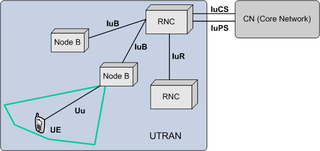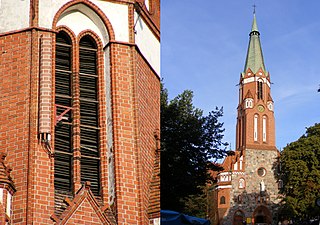
General Packet Radio Service (GPRS) is a packet oriented mobile data standard on the 2G and 3G cellular communication network's global system for mobile communications (GSM). GPRS was established by European Telecommunications Standards Institute (ETSI) in response to the earlier CDPD and i-mode packet-switched cellular technologies. It is now maintained by the 3rd Generation Partnership Project (3GPP).
The Universal Mobile Telecommunications System (UMTS) is a third generation mobile cellular system for networks based on the GSM standard. Developed and maintained by the 3GPP, UMTS is a component of the International Telecommunication Union IMT-2000 standard set and compares with the CDMA2000 standard set for networks based on the competing cdmaOne technology. UMTS uses wideband code-division multiple access (W-CDMA) radio access technology to offer greater spectral efficiency and bandwidth to mobile network operators.
Non-access stratum (NAS) is a functional layer in the NR, LTE, UMTS and GSM wireless telecom protocol stacks between the core network and user equipment. This layer is used to manage the establishment of communication sessions and for maintaining continuous communications with the user equipment as it moves. The NAS is defined in contrast to the Access Stratum which is responsible for carrying information over the wireless portion of the network. A further description of NAS is that it is a protocol for messages passed between the User Equipment, also known as mobiles, and Core Nodes that is passed transparently through the radio network. Examples of NAS messages include Update or Attach messages, Authentication Messages, Service Requests and so forth. Once the User Equipment (UE) establishes a radio connection, the UE uses the radio connection to communicate with the core nodes to coordinate service. The distinction is that the Access Stratum is for dialogue explicitly between the mobile equipment and the radio network and the NAS is for dialogue between the mobile equipment and core network nodes.
The GPRS core network is the central part of the general packet radio service (GPRS) which allows 2G, 3G and WCDMA mobile networks to transmit Internet Protocol (IP) packets to external networks such as the Internet. The GPRS system is an integrated part of the GSM network switching subsystem.
In telecommunications networks, RANAP is a protocol specified by 3GPP in TS 25.413 and used in UMTS for signaling between the Core Network, which can be a MSC or SGSN, and the UTRAN. RANAP is carried over Iu-interface.

UTRAN is a collective term for the network and equipment that connects mobile handsets to the public telephone network or the Internet. It contains the base stations, which are called Node B's and Radio Network Controllers (RNCs) which make up the UMTS radio access network. This communications network, commonly referred to as 3G, can carry many traffic types from real-time Circuit Switched to IP based Packet Switched. The UTRAN allows connectivity between the UE and the core network.

Node B is the telecommunications node in particular mobile communication networks, namely those that adhere to the UMTS standard. The Node B provides the connection between mobile phones (UEs) and the wider telephone network. UMTS is the dominating 3G standard.
GPRS Tunnelling Protocol (GTP) is a group of IP-based communications protocols used to carry general packet radio service (GPRS) within GSM, UMTS, LTE and 5G NR radio networks. In 3GPP architectures, GTP and Proxy Mobile IPv6 based interfaces are specified on various interface points.
The Mobile Application Part (MAP) is an SS7 protocol that provides an application layer for the various nodes in GSM and UMTS mobile core networks and GPRS core networks to communicate with each other in order to provide services to users. The Mobile Application Part is the application-layer protocol used to access the Home Location Register, Visitor Location Register, Mobile Switching Center, Equipment Identity Register, Authentication Centre, Short message service center and Serving GPRS Support Node (SGSN).
RNSAP is a 3GPP signalling protocol responsible for communications between RNCs Radio Network Controllers defined in 3GPP specification TS 25.423. It is carried on the lur interface and provides functionality needed for soft handovers and SRNS relocation. It defines signalling between RNCs, including SRNC and DRNC.
SRNC | DRNC | IUR | RNSAP | RNSAP | | |

E-UTRA is the air interface of 3rd Generation Partnership Project (3GPP) Long Term Evolution (LTE) upgrade path for mobile networks. It is an acronym for Evolved Universal Mobile Telecommunications System (UMTS) Terrestrial Radio Access, also referred to as the 3GPP work item on the Long Term Evolution (LTE) also known as the Evolved Universal Terrestrial Radio Access (E-UTRA) in early drafts of the 3GPP LTE specification. E-UTRAN is the initialism of Evolved UMTS Terrestrial Radio Access Network and is the combination of E-UTRA, user equipment (UE), and E-UTRAN Node B or Evolved Node B (eNodeB).
Vertical handover or vertical handoff refers to a network node changing the type of connectivity it uses to access a supporting infrastructure, usually to support node mobility. For example, a suitably equipped laptop might be able to use both high-speed wireless LAN and cellular technology for Internet access. Wireless LAN connections generally provide higher speeds, while cellular technologies generally provide more ubiquitous coverage. Thus the laptop user might want to use a wireless LAN connection whenever one is available and to revert to a cellular connection when the wireless LAN is unavailable. Vertical handovers refer to the automatic transition from one technology to another in order to maintain communication. This is different from a horizontal handover between different wireless access points that use the same technology.

In telecommunications, a femtocell is a small, low-power cellular base station, typically designed for use in a home or small business. A broader term which is more widespread in the industry is small cell, with femtocell as a subset. It connects to the service provider's network via broadband ; current designs typically support four to eight simultaneously active mobile phones in a residential setting depending on version number and femtocell hardware, and eight to sixteen mobile phones in enterprise settings. A femtocell allows service providers to extend service coverage indoors or at the cell edge, especially where access would otherwise be limited or unavailable. Although much attention is focused on WCDMA, the concept is applicable to all standards, including GSM, CDMA2000, TD-SCDMA, WiMAX and LTE solutions.
System Architecture Evolution (SAE) is the core network architecture of mobile communications protocol group 3GPP's LTE wireless communication standard.
A Home Node B, or HNB, is the 3GPP's term for a 3G femtocell or Small Cell.
ATM Adaptation Layer 2 (AAL2) is an Asynchronous Transfer Mode (ATM) adaptation layer, used primarily in telecommunications; for example, it is used for the Iu interfaces in the Universal Mobile Telecommunications System, and is also used for transporting digital voice. The standard specifications related to AAL2 are ITU standards I.363.2 and I366.1.
HNBAP is a control protocol found in Home Node B networks on the Iu-h interface.
A Home eNodeB, or HeNB, is the 3GPP's term for an LTE femtocell or Small Cell.
TR-196 is a Broadband Forum technical specification. Its official title is "Femto Access Point Service Data Model." The purpose of this Technical Report is to specify the Data Model for the Femto Access Point (FAP) for remote management purposes using the TR-069 CWMP.

E-UTRAN Node B, also known as Evolved Node B, is the element in E-UTRA of LTE that is the evolution of the element Node B in UTRA of UMTS. It is the hardware that is connected to the mobile phone network that communicates directly wirelessly with mobile handsets (UEs), like a base transceiver station (BTS) in GSM networks.






